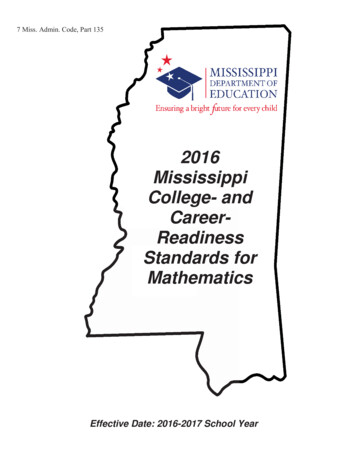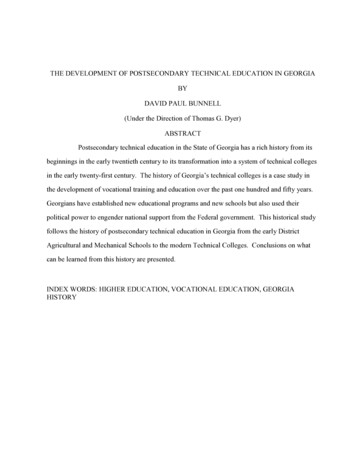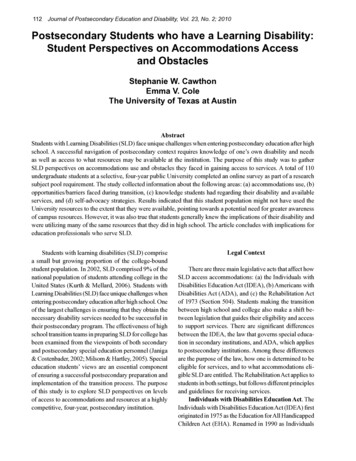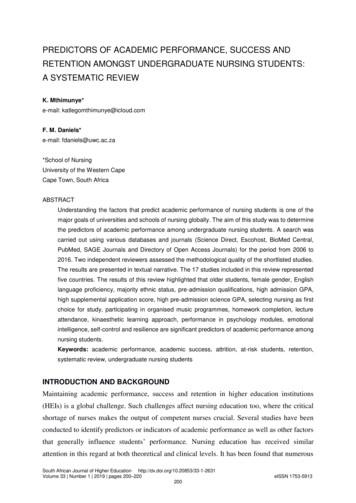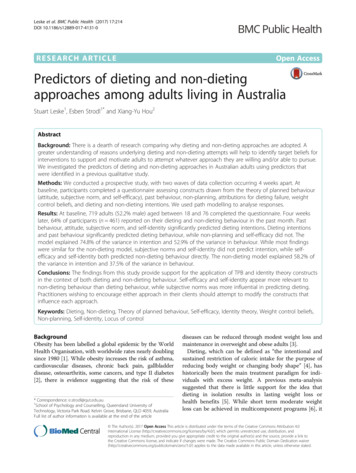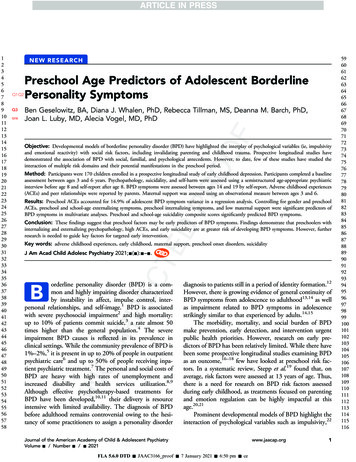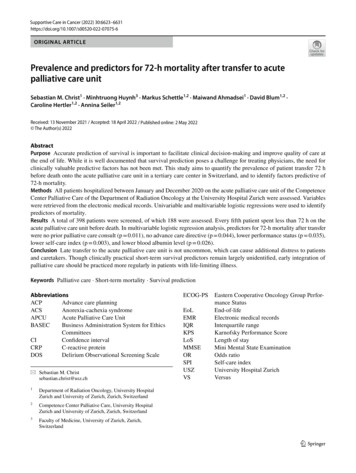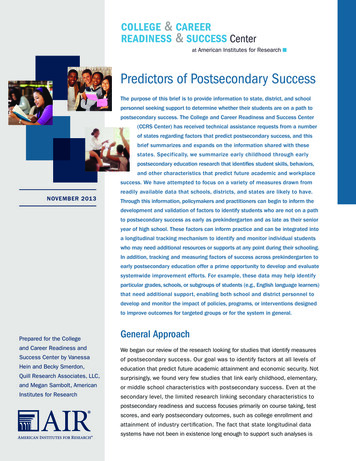
Transcription
Predictors of Postsecondary SuccessThe purpose of this brief is to provide information to state, district, and schoolpersonnel seeking support to determine whether their students are on a path topostsecondary success. The College and Career Readiness and Success Center(CCRS Center) has received technical assistance requests from a numberof states regarding factors that predict postsecondary success, and thisbrief summarizes and expands on the information shared with thesestates. Specifically, we summarize early childhood through earlypostsecondary education research that identifies student skills, behaviors,and other characteristics that predict future academic and workplacesuccess. We have attempted to focus on a variety of measures drawn fromreadily available data that schools, districts, and states are likely to have.NOVEMBER 2013Through this information, policymakers and practitioners can begin to inform thedevelopment and validation of factors to identify students who are not on a pathto postsecondary success as early as prekindergarten and as late as their senioryear of high school. These factors can inform practice and can be integrated intoa longitudinal tracking mechanism to identify and monitor individual studentswho may need additional resources or supports at any point during their schooling.In addition, tracking and measuring factors of success across prekindergarten toearly postsecondary education offer a prime opportunity to develop and evaluatesystemwide improvement efforts. For example, these data may help identifyparticular grades, schools, or subgroups of students (e.g., English language learners)that need additional support, enabling both school and district personnel todevelop and monitor the impact of policies, programs, or interventions designedto improve outcomes for targeted groups or for the system in general.Prepared for the CollegeGeneral Approachand Career Readiness andWe began our review of the research looking for studies that identify measuresSuccess Center by Vanessaof postsecondary success. Our goal was to identify factors at all levels ofHein and Becky Smerdon,education that predict future academic attainment and economic security. NotQuill Research Associates, LLC,surprisingly, we found very few studies that link early childhood, elementary,and Megan Sambolt, Americanor middle school characteristics with postsecondary success. Even at theInstitutes for Researchsecondary level, the limited research linking secondary characteristics topostsecondary readiness and success focuses primarily on course taking, testscores, and early postsecondary outcomes, such as college enrollment andattainment of industry certification. The fact that state longitudinal datasystems have not been in existence long enough to support such analyses is
most likely a significant contributing cause. For this reason, we instead searched forstudies across all grade levels that identify factors that predict future, more proximalacademic success (e.g., kindergarten readiness correlated with third-grade readingproficiency) and conducted an explicit search for studies examining predictors of careersuccess. In this way, the brief is not a research summary of secondary and postsecondarysuccess factors per se; instead, this brief presents a continuum of key factors at eachlevel of education that are linked to future achievement and attainment. The informationprovided in this brief offers a starting point that states, districts, and schools may use todevelop and test contextually valid and reliable factors that measure progression towardpostsecondary success along the PK–16 spectrum.For the purposes of the brief, we chose to include a broad range of benchmarks of futuresuccess and present our findings using three categories: (1) indicators, (2) predictors, and(3) other potential factors.¡ Indicators are measures with an established threshold. Students who perform ator above the threshold (e.g., students who earn a 3.0 grade point average [GPA]or higher) are more likely to be prepared for their college and career pursuits.¡ Predictors are measures that are strongly correlated with improved postsecondaryoutcomes but for which a numeric threshold has not been established.¡ Other potential factors are skills and attributes that have been identified as importantto students’ success and are driven by sound theoretical arguments (e.g., collaborativeskills are important for future success) but for which reliable metrics have not yetbeen developed or tested independently of other factors.None of the indicators, predictors, or other potential factors are intended to be usedindependently; rather, they are potentially valuable components of a comprehensive datainformed decision process designed to improve postsecondary success for all students.To focus our search, we used key search terms, such as 21st century learning skills,predictors of college success, college and career readiness measures, college and careerready predictors, indicators and standards, college admissions criteria, and workforce skillsand capabilities, and included studies that met the CCRS Center’s review criteria.1 Wereviewed more than 80 research studies and summarized and sorted the informationby measure type (indicator, predictor, and other potential factors).Research on this topic is fairly new; thus, there is a need for additional research andevaluation of identified measures. This brief is not intended to serve as a complete orcomprehensive guide, and there are two important limitations to consider. First, mostof the measures included in this brief have not been directly linked to postsecondary12Those criteria include: published from 2000 forward, published in a peer-reviewed journal, released by theInstitute of Education Sciences, What Works Clearinghouse review, National Center for Education Statisticsreport, or published by an organization with rigorous internal review procedures.Predictors of Postsecondary Success
success. Instead, as mentioned previously, the measures have been linked to more proximalacademic successes. Second, there is very little research that focuses specifically on specialstudent populations, such as English language learners, students with disabilities, or privateor home schooled students (Kearns et al., 2011). Thus, this brief is not designed to identifyfactors that predict postsecondary readiness and success for specific student subgroups.Summary of ResearchIn the pages that follow, we summarize the research findings organized by level of education:early childhood (prenatal through kindergarten, elementary (Grades 1–4), middle years(Grades 5–8), high school (Grades 9–12), postsecondary (Years 1 and 2 at both two- andfour-year institutions), and adult education.Early ChildhoodAt this time, there are no studies that identify early childhood indicators of postsecondarysuccess (see Table 1). There are only a small number of early childhood predictors ofpostsecondary readiness (e.g., academic and social adjustment) and considerably moreother potential factors.The early childhood predictors that we found are components of a larger set of classroomcompetencies, or early approaches to learning, which have been researched across gradelevels and relate to future readiness (e.g., mathematics and reading scores in the thirdgrade and grade promotion in the fourth grade)( Li-Grining, Votruba-Drzal, MaldonadoCarreño, & Haas, 2010). These predictors include persistence, emotion regulation, andattentiveness (Hair, Halle, Terry, Lavelle, & Calkins, 2006). In addition, participation inschool-readiness screenings and preschool programming has been significantly related tofuture school success. Finally, the following predictors also have been identified as contributingto children’s readiness for school: physical health, social-emotional development, approachesto learning, language, and cognitive development (Hair et al., 2006; Li-Grining et al., 2010).Some of the other potential factors that we found that relate to school readiness include:working memory skills; the display of positive play interactions with other students,teachers, and family members; and the ability to remain engaged in a task until the taskis complete (Coolahan, Fantuzzo, Mendez, & McDermott, 2000; DiLalla, Marcus, & WrightPhillips, 2004; Fantuzzo & McWayne, 2002; McClelland, Acock, Piccinin, Rhea, & Stallings,2012). Research on these factors has found these skills are related to spelling andwriting scores through age 7, and students who exhibit these skills and behaviors aremore likely to be successful in the core subject areas of reading and mathematics fromkindergarten to the fifth grade (Gathercole, Brown, & Pickering, 2003).3Predictors of Postsecondary Success
Table 1. Early Childhood Correlates of School Readiness and Elementary PerformanceEarly ChildhoodIndicatorPredictor¡ Participation in child care andearly educationa¡ Early approaches to learningb¡ Positive “school readiness riskprofile”cOther Potential Factor¡ Cognitive understanding andcognitive controld¡ Positive play interaction behaviorsat home and schoole¡ Emergent literacyf¡ Working memory skillsg¡ Social-emotional learningh¡ Attention span persistenceiaMagnuson, Meyers, Rhum, & Waldfogel, 2004; bLi-Grining et al., 2010; cHair et al., 2006; dLeerkes, Paradise,O’Brien, Calkins, & Lange, 2008; eCoolahan et al., 2000; Dilalla et al., 2004; Fantuzzo & McWayne, 2002;fDoctoroff, Greer, & Arnold, 2006; gGathercole et al., 2003; hDenham & Brown, 2010; iMcClelland et al., 2012Elementary SchoolWithin the elementary school research literature, we did not find studies that identifyelementary school indicators of postsecondary success. However, research did identifytwo elementary school indicators that predict proximal, future academic success (seeTable 2). First, achieving literacy by the third grade is correlated with reading and Englishlanguage arts (ELA) proficiency on state assessments at the middle grades level (ACT,2008; Silver & Saunders, 2008). Moreover, students in Grades K–3 who are absentfewer than 10 percent of the time are more likely to be promoted to the next gradeand to receive higher grades in core subject areas.2We also found that certain social skills and behavioral predictors are correlated withfuture academic achievement. The Social Skills Rating System assesses components ofstudent behavior, which have been shown to be linked with relationships and which, inturn, are associated with improved social adjustment and academic achievement (Malecki& Elliot, 2002). The multi-rater tool collects perspectives from teachers, parents, andstudents and assesses the following social skills: cooperation, assertion, responsibility,empathy, and self-control.The most common other potential factor at the elementary school level is the demonstrationof social competence. Social competence is the ability to develop and maintain interpersonalrelationships with others (Cotugno, 2009). However, the definition of social competence isnot consistent across studies, nor is its measurement. However, social competence is stillconsidered a potential predictor of both academic and social progress (Rubin & RoseKrasnor, 1992).24A variety of psycho-social skills assessments, including Grit Scales, and their measurements can found 8/0/4/3804146/workshop 4 - dr aaron jarden -positive psychological assessment workbook.pdfPredictors of Postsecondary Success
Table 2. Elementary School Correlates of Elementary and Middle Grades Successand Secondary ReadinessElementary SchoolIndicatorPredictora¡ Reading by the third grade¡ 10 percent absenteeism inelementary schoolb¡ Being rated highly by teachers onattention span and classroomparticipationc¡ High scores on the Social SkillsRating SystemdOther Potential Factor¡ Social competenceeaThe Annie E. Casey Foundation, 2010; Hernandez, 2012; bChang & Mariajose, 2008; cAlexander, Entwisle, &Dauber, 1993; dMalecki & Elliot, 2002; eWelsh, Parke, Widaman, & O’Neil, 2001Middle GradesAt the middle grades level, we found a number of indicators of secondary-level success(see Table 3). For example, attendance rates have a relationship with on-time high schoolgraduation. Students who do not exceed the critical threshold of 20 percent absences peryear display a lower rate of core course failure and grade retention in the middle grades(Balfanz, 2009). In the fifth and sixth grades, passing all ELA and mathematics coursesis correlated with meeting benchmarks on assessments in future grades. Furthermore,beginning in the eighth grade, indicators specify course-taking pathways and benchmarkscores on national assessments that relate to future success, such as passing Algebra Iand scoring at or above 292 on the National Assessment of Educational Progress (NAEP)in mathematics (Wimberly & Noeth, 2005). ACT and SAT also have established collegepreparatory exam thresholds for middle grades students that correlate with high schoolacademic success, such as meeting benchmark scores on state-administered proficiencytests in core subject areas and enrollment in honors and accelerated courses (ACT, 2008;Silver & Saunders, 2008).Predictors of future success for middle grades students include meeting the benchmarkscores on cognitive assessments, such as the Grit Scale, a self-assessment that measuresstudent characteristics (e.g., focus, interest levels, commitment, and follow-through) thathave been shown to predict student ability to continue the pursuit of academic goals despiteuncertainty, risk of failure, or feelings of frustration. High scores on the Grit Scale arecorrelated with positive outcomes at multiple levels. In the middle grades, high scores arecorrelated with higher student GPAs, and one study asserts that, in adulthood, high scoresalso correlate with fewer career changes over time (Duckworth & Quinn, 2009).335A variety of psycho-social skills assessments, including Grit Scales, and their measurements can be found 8/0/4/3804146/workshop 4 - dr aaron jarden - positivepsychological assessment workbook.pdfPredictors of Postsecondary Success
The literature also suggests other potential factors in the middle grades, such as criticalthinking and the ability to make informed decisions, which have been correlated withsecondary-level academic achievement. For example, one study found a correlationbetween seventh-grade predictors and 10th-grade academic achievement (Fleming et al.,2005). In addition, social and emotional learning (SEL) skills that have been found to berelated to future achievement include emotional expression, support-seeking behaviors,and direct problem-solving and cognitive decision-making skills (Fedorowicz, 1995).4Table 3. Middle Grades Correlates of Secondary Success and Postsecondary ReadinessMiddle GradesIndicatorPredictor¡ Taking rigorous coursework in the¡ 20 percent absenteeism in themiddle gradesimiddle gradesa¡ Remaining at the same school¡ High scores on the Grit-S andthrough the middle gradesbGrit-O scalesj¡ Receiving no unsatisfactorybehavior grades in sixth gradec¡ Passing all ELA and mathematicscourses and meeting benchmarkson state examsd¡ Passing Algebra I in the eighthgradee¡ NAEP mathematics score of 292in eighth gradef¡ Meeting the following benchmarkson college preparatory exams: ACTEXPLORE test scores of English13, mathematics 17, science 20and reading 15g; SAT-9 score 50th percentilehOther Potential Factor¡ Social-emotional and decisionmaking skillskaBalfanz, 2009; Balfanz, Herzog, & Mac Iver, 2007; Rumberger, 1995; Rumberger & Larson, 1998; bMac Iver,Durham, Plank, Farley-Ripple, & Balfanz, 2008; Rumberger & Larson, 1998; cBalfanz et al., 2007; dBalfanz et al.,2007; Cumpton, Schexnayder, & King, (2012); eKurlaender, Reardon, & Jackson, 2008; Wimberly & Noeth, 2005;fLee, 2013; gACT, 2008; hSilver & Saunders, 2008; iAtanda, 1999; Wimberly & Noeth, 2005; jDuckworth & Quinn,2009; kFleming et al., 2005High SchoolAt the high school level, we found numerous indicators, predictors, and other potentialfactors due to the breadth of research conducted on this particular school-level transition(see Table 4). The most frequently noted indicators at this level are attendance, GPA, andtest scores. Missing no more than 10 percent of school days per grade level is primarilyassociated with on-track high school graduation (Allensworth & Easton, 2007). Maintaininghigher than a 3.0 high school GPA or passing high school exit exams or college entrance46More information on the Children’s Coping Strategies Checklist can be found at: ools/measure-profile?id 352Predictors of Postsecondary Success
exams correlated with enrolling in and successfully completing credit-bearing entry-levelcollege courses (ACT, 2012; Mishook et al., 2012).5 Meeting or exceeding benchmarkscores on state and national assessments also are indicative of future success (Cumptonet al., 2012). Specific course-taking pathways and participation in college preparatoryprogramming also have been shown to be correlated with future success. For example, thecompletion of Algebra I in the eighth grade and Algebra II in the ninth grade is inverselycorrelated with the need for remediation at the postsecondary level (CRIS AnnenbergInstitute for School Reform, 2010; Klepfer & Hull, 2012; Lee, 2012, 2013). Scoring a 3or higher on Advanced Placement (AP) final exams or a 4 or higher on the InternationalBaccalaureate (IB) final exam in any AP or IB course, or participation in dual enrollmentprogramming, is positively correlated with college enrollment and persistence rates in thefirst two years of a degree or certificate-seeking program (Karp, Calcagno, Hughes, Jeong,& Bailey, 2007; Nagaoka, Roderick, & Coca, 2009; Rumberger & Larson, 1998; Wiley,Wyatt, & Camara, 2010). Similarly, findings from research conducted by SAT and ACTindicate thresholds on their respective college entry exams positively correlate withcollege- and career-readiness outcomes, such as enrollment in a two- or four-year degreeprogram and completion of credit-bearing, entry-level courses without remediation (ACT,2010). In addition, the submission of both the Free Application for Federal Student Aid(FAFSA) and a college application, coupled with immediate, full-time enrollment in apostsecondary academic or career-focused program, also are positively correlated withpostsecondary persistence (Nagaoka et al., 2009).Other indicators that have more recently gained attention are participation in collegepreparatory activities, such as summer transition and orientation programs, as well as highschool-to-college bridge programs (Barnett et al., 2012; Mishook, 2012). Some of theseprograms include the opportunity to earn college credit but focus primarily on conative skilldevelopment and easing the transition process. Program activities include meeting withacademic advisors and guidance counselors and completing college-readiness lessons orpretests for college entrance exams (Barnett et al., 2012; Mishook, 2012). As with all ofthe measures described in this brief, it is important to note that this research is based oncorrelational studies, not causal studies. In addition, none of the studies we reviewed trackstudents beyond the completion of the second year of postsecondary schooling.At this level, there also are a few predictors of secondary and postsecondary success. Forexample, low-mobility or school transfer rates between grades have been widely studiedand identified as predictors of academic success. One study found that even one schooltransfer between Grades 8 and 12 is correlated with a dropout rate that is twice as highas observed for students who do not transfer (Rumberger & Larson, 1998).57SAT College and Career Readiness Benchmark can be found at areer-readiness-benchmark.Predictors of Postsecondary Success
Other potential factors at the secondary level are primarily derived from emergent research.For example, research suggests that students who possess five core SEL skill sets (selfawareness, self-management, social awareness, relationship skills, and responsibledecision making) exhibit higher academic performance in college and better manage theanxiety and workload that college courses entail when compared with students who do notpossess these skills (Dymnicki, Sambolt, & Kidron, 2013). In addition, these five core skillsets of SEL, as well as other SEL skills, are valuable to prospective employers and havebeen included in numerous work standards, suggesting that those who exhibit these skillsmay have an increased likelihood of becoming employed. For example, the National WorkReadiness Credential (NWRC) measures skills such as time management, conscientiousness,self-efficacy, cooperative behavior, and openness to new ideas to assess the degree to whichpotential employees exhibit 21st century workforce skills (ACT, 2011). Demonstration ofthese skills increases employability for entry-level positions in high-demand jobs becauseobtaining the NWRC places the work-ready applicant into a referral network of businessand industry leaders seeking employees with these specific skill sets (Casner-Lotto &Barrington, 2006).8Predictors of Postsecondary Success
Table 4. High School Correlates of Secondary and Postsecondary SuccessFootnotes: 6 7 8 9High School and Career and Technical EducationIndicatora¡ 10 percent absences¡ No more than one failure ofninth-grade subjectsb¡ Completing the followingmathematics sequence: Algebra II(ninth grade), geometry (10thgrade), Algebra III andtrigonometry or higher (11thgrade), precalculus or calculus(12th grade)c¡ 3.0 HS GPAd¡ AP Exam: 3 or higher; IB Exam: 4or highere¡ Dual enrollment participationf¡ Passing state examsg¡ FAFSA completionh¡ Meeting the following benchmarkson national assessments: 10thgrade NELS6 Scale Score 54;12th grade NAEP Score 320;12th grade ECLS7 Score 141i¡ Meeting the following benchmarkson college preparatory exams: SAT 15508; PLAN9 test scores:English 15, reading 17, mathematics19, and science 21; ACT scores:English 18, mathematics 22,reading 21, and science 24j¡ Participation in the following:summer bridge programs, schoolyear transition programs, senioryear transition courses, and earlyassessment and interventionprograms¡ College Knowledge target outreachprograms such as: multiyearcollege-readiness programs,embedded college counseling,and college-readiness lessonskPredictorOther Potential Factor¡ Few school transfers betweengradesl¡ Early Assessment Program (EAP)and Preliminary ScholasticAptitude Test (PSAT) completionm¡ Participation in SEL interventionn¡ Meeting with academic advisoro¡ ACT Work Keysp, NWRC based onEquipped for the Future standards,and the CASAS Workforce¡ Skills Certification SystemqaAllensworth & Easton, 2007; bKemple, Segeritz, & Stevenson, 2013; cKlepfer & Hull, 2012; dMishook et al.,2012; eNagaoka et al., 2009; Wiley et al., 2010; fKarp et al., 2007; gCumpton et al., 2012; hNagaoka et al., 2009;iLee, 2012, 2013; jACT, 2012; kBarnett et al., 2012; Mishook et al., 2012; lRumberger & Larson, 1998; mMishooket al., 2012; nTaylor & Dymnicki, 2007; oKlepfer & Hull, 2012; pBragg & Ruud, 2007; qDarche & Stern, 201396The National Education Longitudinal Study (NELS)7The Early Childhood Longitudinal Program (ECLS)8SAT College and Career Readiness Benchmark retrieved from areer-readiness-benchmark9The PLAN is a 10th-grade assessment developed by ACT that measures progress at the secondary level in thefour core subject areas of mathematics, English, reading, and science.Predictors of Postsecondary Success
Postsecondary and BeyondIndicators of postsecondary success include high GPA, adequate credit load, and passinggeneral education courses without the need for remediation within the first two years ofcollege (see Table 5) (Moore & Shulock, 2009; Roderick, Nagaoka, & Coca, 2009).Maintaining a 3.0 GPA or higher and attending college full-time, as defined by earning 30credits within the first year, are correlated with on-time degree completion (Leinbach &Jenkins, 2008). Similarly, college students enrolled in four-year institutions who takeremedial courses are more likely to drop out of college or transfer to a two-year institution(Attewell, Lavin, Domina, & Levey, 2006; Bettinger & Long, 2004). For students transferringto four-year institutions from community colleges, completing foundational or “gatewaycourses” in mathematics and English and one college-level science course within the firsttwo years has been strongly correlated with future postsecondary success as well (Moore& Shulock, 2009). For adult education, two indicators for success have been identified:obtaining a GED and receiving a Comprehensive Adult Student Assessment Systems(CASAS) composite score above 256 (Wachen, Jenkins, & Van Noy, 2010). The CASASassessment was designed to measure adult mathematics, reading, writing, listening,and speaking skills in order to identify career pathways that are best suited tostudents’ abilities.The predictors of postsecondary success include participation in college and careerorientation and baccalaureate transfer programs and maintaining a combination offull-time enrollment and part-time employment status (Leinbach & Jenkins, 2008).Some research has found that involvement in extracurricular activities and membershipin on-campus student organizations predict success in the form of sustained positiveacademic, psychological, and civic engagement (Aud, Ramani, & Frohlich, 2011;Fredricks & Eccles, 2006).Other potential factors that relate to postsecondary success are limited to the areaof adult education and are largely dependent on data provided by workforce innovationagencies. Findings from research conducted on the Integrated Basic Education and SkillsTraining (I-BEST) model suggest that adult students who enroll in postsecondary programswith the intentions of pursuing a vocational career fare better in achieving their careeroriented goals when compared to other adult students enrolling in postsecondaryprograms strictly for academic purposes (Wachen et al., 2010).101010More information on I-BEST can be found at http://www.sbctc.ctc.edu/college/e ictors of Postsecondary Success
Table 5. Postsecondary Correlates of Subsequent Postsecondary SuccessPostsecondary and BeyondIndicatorTwo- and Four-Year Institutions¡ Completion of mathematics andEnglish gateway courses andcareer exploration coursea¡ 15 credits per quarterb¡ Experience and orientationprogram¡ 3.0 GPAcAdult Education¡ GED; 256 on mathematics,reading, and listening on CASASdPredictorTwo- and Four-Year Institutions¡ Enrollment in a baccalaureatetransfer programe¡ Immediate enrollment after highschool graduation¡ Working less than 15 hours perweek¡ Participation in extracurricularactivities; high educationalexpectations for selffOther Potential FactorAdult Education¡ Vocational intentgaMoore & Shulock, 2009; bLeinbach & Jenkins, 2008; cMoore & Shulock, 2009; dWachen et al., 2010;eLeinbach & Jenkins, 2008; fAud et al., 2011; gConley, 2007Reflections on the Review of LiteratureIn our review of the literature, we identified potential directions for research that may proveuseful in informing both policy formulation and practical application. First, as previouslymentioned in this brief, research on benchmarks for postsecondary success is emergent,and there is a dearth of reliable indicators of postsecondary success. Second, there is little,if any, research on special student populations. Therefore, the field would benefit from moreempirical research. Third, the research that we reviewed is correlational and not causal;thus, indicators, predictors, and other potential factors should not be considered causes offuture outcomes. Finally, from what we have gleaned from the review of the research, thesestudies tend to test factors independently of, rather than in conjunction with, other proposedfactors of success. There is little evidence to suggest that postsecondary predictors arebeing used together to provide students with a comprehensive snapshot of their own levelof preparedness as they move through each grade level (Conley, 2007). If postsecondarypredictors are used collectively, states, districts, and schools can develop self-assessmenttools or checklists that can serve as personal tracking guides for students as they progressthrough school.11Predictors of Postsecondary Success
RecommendationsBased on our review of the research and our experience working with states, districts,and schools using data to inform decision making, we have developed a list ofrecommendations for consideration when using postsecondary success indicators,predictors, and other potential factors:1. Continue building comprehensive, user-friendly state, district, and school datasystems that allow data linkages across prekindergarten to workforce in orderto identify indicators for readiness and success that are applicable across gradelevels and in both career-related and academic postsecondary environments.2. Create measures that correlate with postsecondary success and other proximaloutcomes, and test the measures with multiple cohorts of students who havemoved or are moving through your system. This testing will ensure these measuresare valid and reliable in your local context. Examine potential differences, by studentsubgroups, to make sure the measures work for all students in your schools, andadjust as necessary if there are subgroup differences.3. Integrate measures of readiness and success into your data systems, and usethese measures and data systems to identify and intervene with struggling studentsand to evaluate the effectiveness
elementary school indicators of postsecondary success. However, research did identify two elementary school indicators that predict proximal, future academic success (see Table 2). First, achieving literacy by the third grade is correlated with reading and English language arts (ELA) proficiency on state assessments at the middle grades level (ACT,
